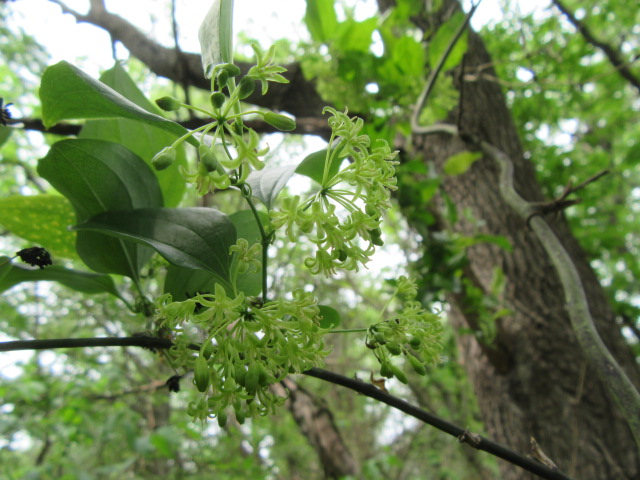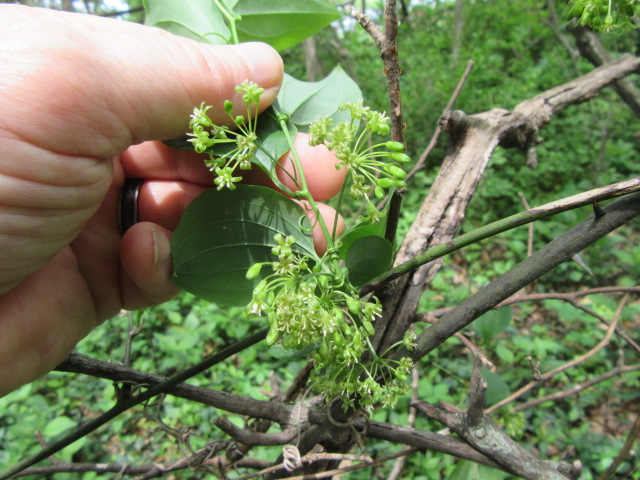
Smilax tamnoides (Bristly Greenbriar) on 7-17-21, #813-51.
Bristly Greenbriar, Hag Briar, Sarsaparilla Plant, Bamboo Vine, Catbriar
Smilax tamnoides
SMIL-aks tam-NOY-deez
Synonyms of Smilax tamnoides (7) (Updated on 12-26-23 from Plants of the World Online): Dilax muricata Raf., Smilax grandifolia Buckley, Smilax hispida Muhl. ex Torr., Smilax hispida var. australis Small, Smilax hispida var. montana Coker, Smilax medica G.Kirchn, Smilax tamnoides var. hispida Fernald
Smilax tamnoides L. is the accepted scientific name for this species of Smilax. The genus and species were named and described as such by Carl von Linnaeus in the second volume of the first edition of Species Plantarum in 1753.
As of 12-26-23 when this page was last updated, Plants of the World Online lists 267 species in the Smilax genus. It is a member of the plant family Smilacaceae with only one genus… Those numbers could change as updates are made on POWO.

Distribution map of Smilax tamnoides from Plants of the World Online. Facilitated by the Royal Botanic Gardens, Kew. Published on the Internet; http://www.plantsoftheworldonline.org/. Retrieved on April 30, 2021.
The above distribution map for Smilax tamnoides is from Plants of the World Online. The map on the USDA Plants Database for the United States and Canada is the same.
The map on iNaturalist shows where members have made observations. Anyone can join and it is a great website to confirm and share your observations. The maps on iNaturalist are continually updated as new observations are made.
THERE ARE SEVERAL LINKS AT THE BOTTOM OF THE PAGE FOR FURTHER READING AND TO HELP WITH A BETTER POSITIVE ID.

Smilax tamnoides (Bristly Greenbriar) on 5-3-20, #695-47.
It may sound a little strange, but I find Smilax tamnoides an interesting species despite its somewhat thorny disposition. There are several areas on the farm where it grows in the trees, especially in a wooded area north of the chicken house. They prefer to grow in wooded areas, but one made itself at home on a new gate in the south pasture in full sun in 2021. When I was giving this page a makeover on May 10 in 2023, I went to the south hayfield to see if I could find flowers on the vines growing on the gate. It was completely gone! Then I checked the vines north of the chicken house and found flowers. Read on…
THERE ARE MORE PHOTOS UNDER THE LINKS FOR FURTHER READING AT THE BOTTOM OF THE PAGE.

Smilax tamnoides (Bristly Greenbriar) on 5-3-20, #695-48.
Smilax tamnoides is a perennial vine native to North America that can be found from the central part of the U.S. eastward, down to Northeast Mexico, and north to the District of Columbia in Canada. The species could be more widespread than what the maps show.

Smilax tamnoides (Bristly Greenbriar) on 5-10-23, #938-37.
The vines may grow forever, at least to 20’+. I am not going to drag one out of a tree to measure it. It enjoys climbing on trees, shrubs, fences, or anything its tendrils will cling to. It prefers light to part shade (part sun) in fairly moist soil but can also tolerate a little drought. Around here, it likes fertile loamy soil.

Smilax tamnoides (Bristly Greenbriar) on 5-3-20, #695-58.
The vines are round and green, sometimes with small ridges or vertical lines. Along with the sharp, stiff spines, there are also A LOT of smaller bristles. The spines and bristles start out green but turn a dark gray or brownish color with age.

Smilax tamnoides (Bristly Greenbriar) on 5-3-20, #695-56.
New stems, or the upper part of the vines, may have no spines at all. In fact, on some vines, the only thorns may be on the lower 3-4′, or maybe a thorn here and there.

Smilax tamnoides (Bristly Greenbriar) on 7-8-21, #809-36.
The above photo is of the thorny friend that “was” on the gate in the south hayfield.

Smilax tamnoides (Bristly Greenbriar) on 5-3-20, #695-51.
The leaves grow in an alternate pattern along the stems and grow to around 5” long and 4” across. The leaves are narrowly to broadly ovate, and glabrous (not hairy).

Smilax tamnoides (Bristly Greenbriar) on 7-8-21, #809-33.
A new boundary fence was installed along the south hayfield in 2020 with a new gate at the end. In 2021, a Smilax tamnoides took a liking to the gate and went hog wild. The vine had HUGE leaves and was the most robust S. tamnoides I had ever seen. Right out in the full sun. When I was working on this page and adding descriptions on May 8 (2023) a light came on. It was a good time to check to see if I could find flowers. The vine on the gate would be perfect since it wasn’t growing in the trees. I went back to check and it was completely gone to the point there was no evidence it ever existed…

Smilax tamnoides (Bristly Greenbriar) on 7-8-21, #809-34.
The above photo of a leaf underside shows prominent veins beginning at the base, spreading somewhat toward the center, then meeting again at the tip.

The above photo of Smilax tamnoides is from the Missouri Plants website. Missouri Plants is published on the internet at http://www.missouriplants.com/index.html. Photo used by permission and retrieved on 5-9-23.
There are sometimes weird tooth-like projections along the leaf margins that you can’t see without magnification…
My thanks to the administrator of the Missouri Plants website for allowing me to use a couple of their photos. Missouri Plants is great to use for identifying wildflowers with great photos and descriptions. I have relied on Missouri Plants for MANY YEARS. I don’t take very good close-ups, and when I do I think it is by accident. Practice makes perfect.

Smilax tamnoides (Bristly Greenbriar) on 7-8-21, #809-38.
Leaves are attached to the stems by fairly long petioles (leaf stems). Pairs of tendrils grow from many of the leaf nodes along the vines.

Smilax tamnoides (Bristly Greenbriar) on 5-3-20, #695-49.
Umbels of 10-25 flowers occasionally grow from the axils of leaves (where the base of the leaf attaches to the petiole). These umbels are found on the leaves that grow at the end of branches (up in the trees) so they are often overlooked. If you want to see flowers, you may have to do some climbing.
I was fortunate enough to find a smaller vine that was hanging over a few low branches of a tree on May 3 in 2020 in a wooded area on a friend’s farm. Well, at least I was able to take a photo of the buds…

Smilax tamnoides (Bristly Greenbriar) on 5-10-23, #938-32.
On May 10 I left the gate in the south pasture and decided to see if I could find flowers in the wooded area north of the chicken house. I hadn’t noticed any in this area before but it was worth a shot. To my surprise, there were vines from two different plants hanging out of a couple of trees with flowers!

Smilax tamnoides (Bristly Greenbriar) on 5-10-23, #938-33.
Being a dioecious species, Smilax tamnoides produce male and female flowers on different vines. Some of the upper branches produce umbels of flowers that emerge from leaf axils. Each umbel produces 8-30 flowers on fairly long peduncles (2-4 times as long as the leaf petioles).

Smilax tamnoides (Bristly Greenbriar) on 5-10-23, #938-36.
The flower structure of Smilax species is called a perianth and includes a double series of 6 greenish-yellow or grayish-green tepals. A tepal is part of the perianth that cannot be clearly defined as a petal or sepal. Both male (staminate) and female (pistillate) flowers are approximately 1/4” across. Staminate (male) flowers have 6 stamens that may be fused at the base of the filaments. Pistillate (female) flowers have a single ovary with 3 locules and a very short (or absent) style.
Flowers are produced from April-May.

The above photo of Smilax tamnoides is from the Missouri Plants website. Missouri Plants is published on the internet at http://www.missouriplants.com/index.html. Photo used by permission and retrieved on 5-9-23.
The flowers don’t last long and the female flower’s ovaries are replaced by berries that turn dark blue to black. The berries produce 1-3 seeds, sometimes up to 6.
Various species of bees and flies feed on the nectar and pollen of the flowers, and caterpillars of a few species of moths feed on the leaves.
I will continue taking photos of this species as time goes by.
THERE ARE MORE PHOTOS UNDER THE LINKS FOR FURTHER READING…
I have enjoyed photographing and learning about the many wildflowers growing on the family farm and in other areas. The farm is in Windsor, Missouri in Pettis County (Henry County is across the street and Benton and Johnson aren’t far away). I have grown over 500 different plants and identified over 250 species of wildflowers (most have pages listed on the right side of the page). I am not an expert, botanist, or horticulturalist. I just like growing, photographing, and writing about my experience. I rely on several websites for ID and a few horticulturalists I contact if I cannot figure them out. Wildflowers can be somewhat variable from location to location, so sometimes it gets a bit confusing. If you see I have made an error, please let me know so I can correct what I have written.
I hope you found this page useful and be sure to check the links below for more information. They were written by experts and provide much more information. Some sites may not be up-to-date but they are always a work in progress. If you can, I would appreciate it if you would click on the “Like” below and leave a comment. It helps us bloggers stay motivated. You can also send an email to me at thebelmontrooster@yahoo.com. I would enjoy hearing from you especially if you notice something is a bit whacky.
FOR FURTHER READING:
PLANTS OF THE WORLD ONLINE (GENUS/SPECIES)
INTERNATIONAL PLANT NAMES INDEX (GENUS/SPECIES)
TROPICOS (GENUS/SPECIES)
FLORA OF NORTH AMERICA (GENUS/SPECIES)
WORLD FLORA ONLINE (GENUS/SPECIES)
WIKIPEDIA (GENUS/SPECIES)
USDA PLANTS DATABASE
DAVE’S GARDEN
MISSOURI PLANTS
MISSOURI BOTANICAL GARDEN
MSU-MIDWEST WEEDS AND WILDFLOWERS
MISSOURI DEPARTMENT OF CONSERVATION
iNATURALIST
WILDFLOWER SEARCH
ILLINOIS WILDFLOWERS
MINNESOTA WILDFLOWERS
KANSAS WILDFLOWERS AND GRASSES
CLIMBERS-UNIVERSITY OF MICHIGAN
NORTH CAROLINA STATE UNIVERSITY
PFAF(PLANTS FOR A FUTURE)
GO BOTANY
LADY BIRD JOHNSON WILDFLOWER CENTER
MARYLAND BIODIVERSITY PROJECT
NOTE: The data (figures, maps, accepted names, etc.) may not match on these websites. It depends on when and how they make updates and when their sources make updates. Some websites have hundreds and even many thousands of species to keep up with. Accepted scientific names change periodically and it can be hard to keep with as well. Some of the links may use a name that is a synonym on other sites. In my opinion, Plants of the World Online by Kew is one of the most reliable and up-to-date plant databases and they make updates regularly. I make updates “at least” once a year and when I write new pages or add new photos but I do get behind. We are all a work in progress. 🙂
MORE PHOTOS…

Smilax tamnoides (Bristly Greenbriar) on 5-3-20, #695-50.

Smilax tamnoides (Bristly Greenbriar) on 5-3-20, #695-52.

Smilax tamnoides (Bristly Greenbriar) on 5-3-20, #695-53.

Smilax tamnoides (Bristly Greenbriar) on 5-3-20, #695-54.

Smilax tamnoides (Bristly Greenbriar) on 5-3-20, #695-55.

Smilax tamnoides (Bristly Greenbriar) on 5-3-20, #695-57.

Smilax tamnoides (Bristly Greenbriar) on 7-8-21, #809-35.

Smilax tamnoides (Bristly Greenbriar) on 7-8-21, #809-37.

Smilax tamnoides (Bristly Greenbriar) on 7-17-21, #813-48.

Smilax tamnoides (Bristly Greenbriar) on 7-17-21, #813-49.

Smilax tamnoides (Bristly Greenbriar) on 7-17-21, #813-50.

Smilax tamnoides (Bristly Greenbriar) on 7-17-21, #813-52.

Smilax tamnoides (Bristly Greenbriar) on 5-10-23, #938-34.

Smilax tamnoides (Bristly Greenbriar) on 5-10-23, #938-35.

Smilax tamnoides (Bristly Greenbriar) on 5-10-23, #938-38.

Smilax tamnoides (Bristly Greenbriar) on 5-10-23, #938-39.

Smilax tamnoides (Bristly Greenbriar) on 5-10-23, #938-40.